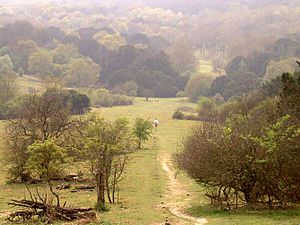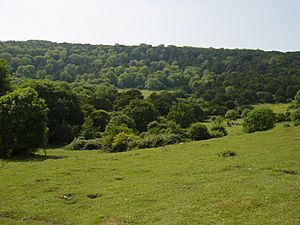Kingley Vale National Nature Reserve facts for kids
| Site of Special Scientific Interest | |
 |
|
| Area of Search | West Sussex |
|---|---|
| Interest | Biological |
| Area | 204.4 hectares (505 acres) |
| Notification | 1986 |
| Location map | Magic Map |
Kingley Vale is a special natural area in West Sussex, England. It's located north of Chichester. This place is a Site of Special Scientific Interest, which means it's protected for its important plants, animals, or geology. It's also a Special Area of Conservation and a top-rated Nature Conservation Review site. A big part of Kingley Vale, about 148 hectares (366 acres), is a National Nature Reserve.
Natural England helps manage this amazing site. You can find an information center here and follow a nature trail. The area has large grassy hills and shrub lands. It's famous for its very old yew trees. From the top of the hills, you can see beautiful views of Sussex and the south coast. There are many paths for walking and horse riding around the reserve. A popular walk takes you through the woodland and past the ancient yew trees, leading up to the hilltops.
You can park your car at West Stoke, which is about five miles northwest of Chichester. There are also footpaths that lead up to Kingley Vale from the village of Stoughton.
Contents
Discovering Kingley Vale's Nature
Kingley Vale is home to one of Europe's most amazing yew forests. Some of these yew trees are incredibly old, possibly up to 2,000 years! This makes them some of the oldest living things in Great Britain. It's quite special that they are still here. Many ancient yew trees across Europe were cut down after the 14th century. This was because their wood was perfect for making English longbows.
In 1472, longbows were very popular. The English government even made a rule called the "yew tax." This meant that for every barrel of wine brought into an English harbor, four pieces of yew wood for bows had to be given. This led to a big search for old yew trees all over Europe. Many forests were destroyed. Kingley Vale is one of the few large groups of yew trees that still remain. Most other yews are found alone or in small groups.
Plants and Trees at Kingley Vale
Besides yew trees, you can find other types of trees here. These include oak, ash, holly, and hawthorn. The chalk grassland is full of different flowers and herbs. They create a colorful mix of plant life.
Wildlife and Animals
Over 50 different kinds of birds live at Kingley Vale. However, only six types of birds build their nests in the yew woodland. You might also spot mammals like deer, yellow-necked mice, water shrews, and dormice. Kingley Vale is also home to 39 types of butterflies. Most of these butterflies live in the grassy areas.
Exploring Ancient History
Kingley Vale has a rich history with many old sites. You can find the remains of a Romano-Celtic temple at Bow Hill. There's an Iron Age settlement called Goosehill Camp. The Devil's Humps are Bronze Age round burial mounds, also known as barrows. You can also find prehistoric flint mines here.
There are other old remains that archaeologists are still studying. These include long earthworks and a rectangular area known as Bow Hill Camp. There is also evidence that people lived at the base of the hill a long time ago.
Images for kids




